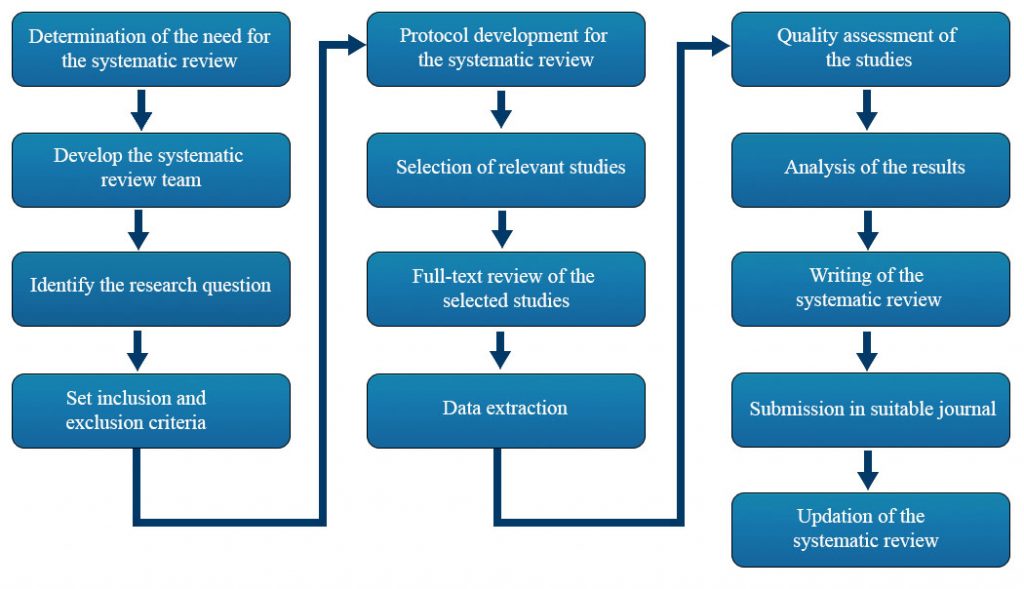Systematic reviews have nowadays become essential tools for assembling available evidence regarding a subject of interest. A systematic review assembles all the experimental evidences and reported studies that fit the pre-set inclusion criteria to answer a specific research question. The use of unambiguous, systematic methods minimizes bias in the review. Thus, the findings of a systemic review are reliable and can be used to draw conclusions and make decisions.

Rationale for systematic review
Systematic reviews are important tools that find importance in the clinical as well as basic research fields. They provide reliable and authenticated clues for medical decision making, planning future research projects, in the establishment of clinical or health policies, and help in the comparative effectiveness research. The most important aspect of systematic reviews is they save a lot of time and funds by preventing unnecessary research.
Components of systematic review
Systematic reviews should start with an evidently pronounced question. The prerequisite of conducting a systematic review is to first prepare a valid and clear question. It should be made clear that around what idea the systematic review should revolve around. Explicit and rigorous methods like the use of combination of appropriate keywords, authentic databases to search for published data about the specified question, strictly following the inclusion and exclusion criteria while listing the published research for the systematic review, critical evaluation of relevant studies, evaluation of the relevant published and unpublished evidence for validity before combining and analyzing data, reporting the methodology, studies included in the review, and conclusions, and reproducibility of the findings are the important components of a systematic review.
Systematic review Vs. Narrative review
In a systematic review, the question to be answered is clear or there is a set hypothesis for the review. In narrative reviews, although sometimes there is a clear question but most often lacks a clear question or hypothesis and involves general discussion of a particular subject.
In a systematic review, all the relevant published and unpublished literature are covered to minimize publication bias but in a narrative review, relevant literature may be missed.
In a systematic review, specific guidelines for the inclusion and exclusion of publications are followed and described in detail while in a narrative review it is not explained why some articles are included and some are excluded from the review.
Systematic reviews examine in a systematic manner the methodology adopted in the primary studies, identifies potential bias in the studies and sources of heterogeneity between study results. Narrative reviews usually omit this checkpoint and include studies without examining potential study biases and heterogeneity between study results. Systematic reviews draw conclusion only based on methodologically correct studies. Narrative reviews include studies irrespective of the differences in the study methods and quality of the studies. These reviews do not differentiate between methodologically correct and incorrect studies. So, the conclusions of systematic reviews are more reliable as compared to narrative reviews.
Systematic review process
Systematic review needs meticulous planning and involves several steps until it reaches the publication stage. The planning of the process starts with the understanding of the need for the review. After the idea about the significance of the review is made clear, a review team is assembled. Then, the question of interest is designed. After a clear idea is developed about the question, inclusion and exclusion criteria are set. This is followed by the protocol development, selection of relevant studies, data extraction, quality assessment of the studies, analysis of the results, and then writing and publication. The systematic reviews are updated if some new evidence is produced. (Figure 1).
Figure 1: Flow chart showing the general protocol for a systematic review.
Systematic review Vs. Meta-analysis
Systematic reviews and meta-analysis are commonly misinterpreted to be the same. There is considerable overlap between a systematic review and a meta-analysis, but they are principally two different methods of summarizing data about a research question.
A meta-analysis involves several statistical approaches to analyze numerical data gathered from different studies. A meta-analysis is always conducted after a systematic review. Meta-analysis does a combined analysis of the extracted data from the included studies and provides statistical values for each study’s effect sizes. Meta-analysis also deals with the publication bias by employing L’Abbé plot, inverted funnel-plots, and forest plots.


